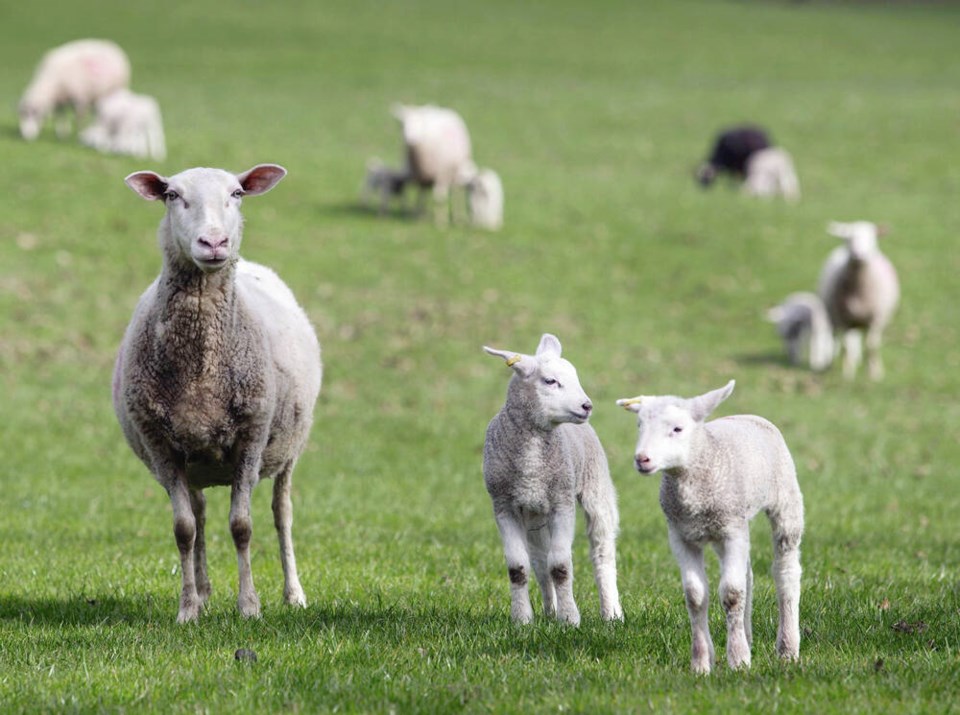Sheep farmer John Buchanan is having a great spring. His flock of ewes gave birth to a near record 780 lambs — including a rare double dose of sextuplets — and the wet, cool spring has made his pastures lush and green.
But Buchanan’s optimism is tempered with worry. With several cougar sightings and confirmed pet-kills this year in the Metchosin-East Sooke area, reports of wolves roaming the area and now bears emerging from hibernation, Buchanan’s Parry Bay Sheep Farm is on high alert.
The Buchanans run about 1,000 ewes on two dozen pastures of various sizes in the region.
Bear attacks on sheep have risen sharply over the years, he said. Two years ago, there were at least 15 kills by bears in the western capital region. The attacks usually happened at night, when the animals were chased down, cornered against a fence and eaten alive. Cougars usually kill and then eat their prey.
“The bears are around … but I haven’t lost any sheep yet,” Buchanan said Tuesday. “You might see an occasional kill this early, but we find bears don’t really get going [after the sheep] until July and August.”
Buchanan is doing regular patrols of his pastures, while residents of grazing areas on the property are keeping a close eye.
He’s heard of a few sheep being taken in East Sooke, likely by cougars.
“Not all bears go after sheep,” said Buchanan. He believes most of the 2020 killings were caused by a single “problem” bear. “But you never know … there could be others.”
Bears emerging from hibernation usually have one thing on their minds — food — “to jump-start their bowels,” said Sgt. Stuart Bates of the Conservation Officer Service.
He said bears will forage for skunk cabbage, dandelions, clover and ferns, but will also go for easy-access garbage, winter-kill carcasses and even newborn fawns and lambs if they are in a bear’s “wandering path and powerful nose,” said Bates.
“A bear’s nose and sense of smell is about six times greater than a bloodhound’s,” he said.
He said bears will disperse into cities and rural areas via greenbelts or shorelines in search of food. Male bears are also wandering to find mates, and females are going out of their way to avoid the males; the major threat to the life of a new cub is often a male bear.
Bates, who operates in a wide area of the central Island, said calls from the public about bear sightings and interactions with humans and their waste have reached 74 since early April. That’s nearly triple the amount of calls over the same period last year and a sharp increase from the 18 calls in 2020, he said.
The City of Nanaimo issued a warning to residents and park users this week after two sightings of a mother bear and two cubs — first in the Colliery Dam Park area and, two days later, in Bowen Park.
Bates said it’s part of a disturbing trend of bears being habituated in urban areas, drawn by garbage and other irresistibles like bird feeders, chicken coops and pet foods — even livestock in the outlying areas.
He said bears have been reported in all areas of Nanaimo this year and into rural areas.
In late April, Bates was called to a rural residence near Qualicum Beach where a bear had broken into a goat enclosure and killed two animals. Bates set a trap using the carcass of one of the goats and almost immediately captured the bear.
The bear was euthanized because it managed to get into a secure structure and received a food reward, a tactic that experience has shown will be repeated.
“We have learned that we can relocate bears and they will either come back or go to another town or farm closer to where we’ve relocated them,” said Bates. “Once they are human-habitualized, it’s a death sentence.”
Bates cited the case of a tagged bear that was relocated from Port Alberni to Mount Arrowsmith. “Three weeks later, 60 kilometres as the crow flies, he ends up on the sidewalk out front of Ladysmith hospital,” said Bates.
Bates said conservation officers often “take it on the chin” for euthanizing bears, but he said “it’s people that kill them” by leaving out garbage and other attractants — or even feeding them.
The Conservation Officer Service said Monday that charges are pending against a Lower Mainland resident in connection with feeding dangerous wildlife in West Vancouver. The service said it “intercepted” the resident, who allegedly spent months feeding bears and coyotes in the area.
Feeding dangerous wildlife is an offence under the B.C. Wildlife Act and could result in fines of up to $100,000.
Environment Minister George Heyman said Tuesday conservation officers are working to put an end to the “dangerous” practice of feeding bears. “It endangers your neighbours, it endangers communities, and it endangers the wildlife that become habituated to that and are ultimately destroyed so they won’t threaten our communities and people,” said Heyman. “Nobody feeds an animal because they want to see it destroyed, but that is the end result.”
The province provides education and responds to reports of such incidents, taking people to court and levying fines if necessary. But Heyman said the province would prefer to use a combination of education and deterrence options “that puts an end to this practice.”
— With files from Cindy E. Harnett



